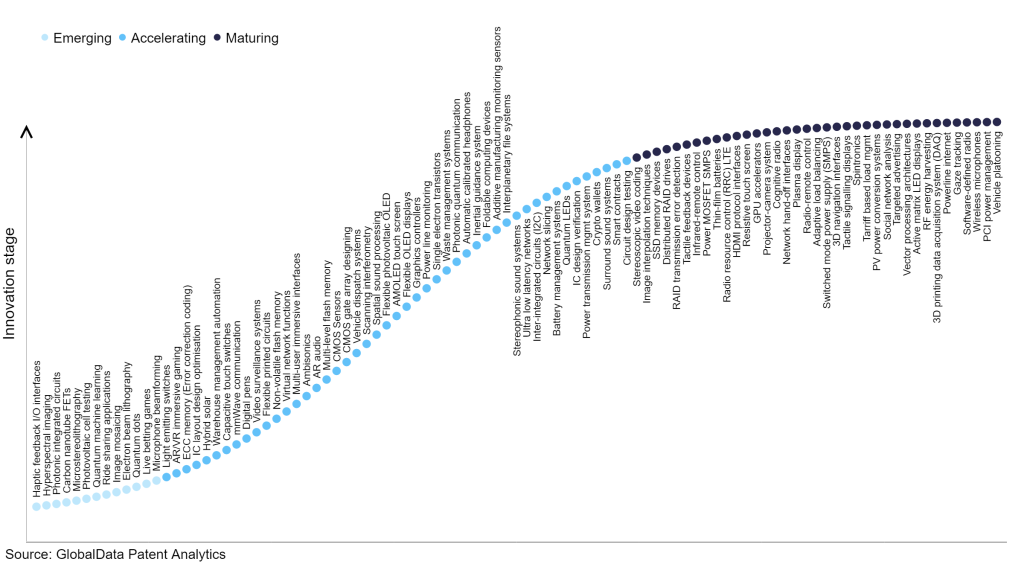The technology industry continues to be a hotbed of innovation, with activity driven by the increasing demand for uninterrupted connectivity, the proliferation of mobile devices, the growing adoption of Internet of Things (IoT) devices, as well as growing importance of network management and authentication mechanisms, and protocols such as Mobile IP, Proxy Mobile IP, and Fast BSS Transition (FT). These technologies work together to ensure smooth hand-off and uninterrupted connectivity, enhancing the user experience and enabling seamless mobility in a connected world. In the last three years alone, there have been over 3.6 million patents filed and granted in the technology industry, according to GlobalData’s report on Technology Innovation: Network hand-off interfaces. Buy the report here.
However, not all innovations are equal and nor do they follow a constant upward trend. Instead, their evolution takes the form of an S-shaped curve that reflects their typical lifecycle from early emergence to accelerating adoption, before finally stabilising and reaching maturity.
Identifying where a particular innovation is on this journey, especially those that are in the emerging and accelerating stages, is essential for understanding their current level of adoption and the likely future trajectory and impact they will have.
300+ innovations will shape the technology industry
According to GlobalData’s Technology Foresights, which plots the S-curve for the technology industry using innovation intensity models built on over 2.5 million patents, there are 300+ innovation areas that will shape the future of the industry.
Within the emerging innovation stage, microphone beamforming, live betting games, and quantum dots are disruptive technologies that are in the early stages of application and should be tracked closely. Circuit design testing, communication, smart contracts, and surround sound systems are some of the accelerating innovation areas, where adoption has been steadily increasing. Among maturing innovation areas are vehicle platooning and PCI power management, which are now well established in the industry.
Innovation S-curve for the technology industry

Network hand-off interfaces is a key innovation area in technology
Network hand-off interfaces refer to the interfaces employed to transfer data between two distinct networks. These interfaces can be either physical or logical and are accountable for facilitating the smooth transmission of data from one network to another. Primarily utilised in large enterprise networks and data centres, network hand-off interfaces play a crucial role in ensuring efficient communication among interconnected networks.
GlobalData’s analysis also uncovers the companies at the forefront of each innovation area and assesses the potential reach and impact of their patenting activity across different applications and geographies. According to GlobalData, there are 20 companies, spanning technology vendors, established technology companies, and up-and-coming start-ups engaged in the development and application of network hand-off interfaces.
Key players in network hand-off interfaces – a disruptive innovation in the technology industry
‘Application diversity’ measures the number of different applications identified for each relevant patent and broadly splits companies into either ‘niche’ or ‘diversified’ innovators.
‘Geographic reach’ refers to the number of different countries each relevant patent is registered in and reflects the breadth of geographic application intended, ranging from ‘global’ to ‘local’.
Patent volumes related to network hand-off interfaces
| Company | Total patents (2010 - 2022) | Premium intelligence on the world's largest companies |
| Intel | 300 | Unlock Company Profile |
| Meta Platforms | 75 | Unlock Company Profile |
| Apple | 68 | Unlock Company Profile |
| Avaya | 50 | Unlock Company Profile |
| Sony Group | 20 | Unlock Company Profile |
| BlackBerry | 20 | Unlock Company Profile |
| Qualcomm | 19 | Unlock Company Profile |
| Canon | 16 | Unlock Company Profile |
| Samsung Group | 15 | Unlock Company Profile |
| Alphabet | 15 | Unlock Company Profile |
| InterDigital | 12 | Unlock Company Profile |
| Seiko Epson | 9 | Unlock Company Profile |
| Incnetworks | 8 | Unlock Company Profile |
| Huawei Investment & Holding | 7 | Unlock Company Profile |
| SZ DJI Technology | 7 | Unlock Company Profile |
| Amazon.com | 7 | Unlock Company Profile |
| Alstom | 7 | Unlock Company Profile |
| NEC | 7 | Unlock Company Profile |
| Rohde & Schwarz | 6 | Unlock Company Profile |
| VeriFone | 6 | Unlock Company Profile |
Source: GlobalData Patent Analytics
Intel is a leading patent filer in the field of network hand-off interfaces. One of the company’s patents describes systems for sending and receiving Channel State Information (CSI) reports in Coordinated Multi-Point (CoMP) schemes. One example system involves user equipment (UE) limiting CSI feedback to one or more transmission points implementing the CoMP scheme. The system also includes a transmission point, such as an evolved node B (eNB), that triggers CSI feedback and receives a CSI report from the UE. The CSI report is generated by the UE by constraining CSI feedback, which can involve generating fewer reports, reusing information between reports, or allowing more time for processing and generating CSI reports.
Other prominent patent filers in the space include Meta Platforms and Apple.
By geographic reach, Intel leads the pack, followed by Avaya and InterDigital. In terms of application diversity, Avaya holds the top position, followed by NEC and Canon.
Network hand-off interfaces are the mechanisms used to facilitate the seamless transfer of network connections between different access points or networks. These interfaces enable uninterrupted connectivity as users move between different network environments, such as from Wi-Fi to cellular networks or between different Wi-Fi networks. Their significance lies in enabling seamless connectivity and effective data transfer across diverse networks within a network infrastructure, enhancing overall network performance and facilitating streamlined operations. To further understand the key themes and technologies disrupting the technology industry, access GlobalData’s latest thematic research report on Technology.
Data Insights
From

The gold standard of business intelligence.
Blending expert knowledge with cutting-edge technology, GlobalData’s unrivalled proprietary data will enable you to decode what’s happening in your market. You can make better informed decisions and gain a future-proof advantage over your competitors.







